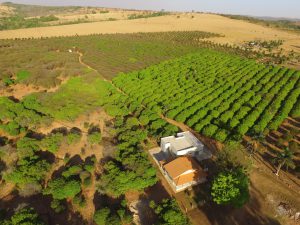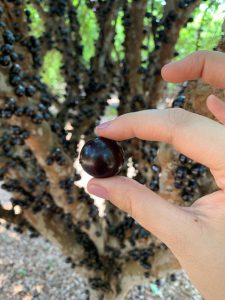Jabuticaba, also known as “Brazilian grape”, is originally from the Brazilian Atlantic Forest. Dark purple on the outside and white on the inside, this fruit has a sweet pulp and a sour kernel, which gives it a unique flavor. The berry is widely consumed throughout the country, but it is an illustrious unknown for many abroad.
Despite having Brazilian origins, it is easily cultivated in humid places, especially ones close to the tropics. There are more than 40 species of jabuticaba, some of them in several other Latin American countries, such as Mexico and Argentina.
The jabuticaba seed takes ten years to grow and to begin bearing fruit. But it is an investment guaranteed to be delicious. Back in 1947, Antonio Batista da Silva realized how life-changing the fruit could be for him. He had recently married Maria da Luz de Jesus and, working as a bricklayer in the countryside of Goiás (central Brazil), he had to seek an alternative way of making money.
Antonio left the farm in an ox cart to sell fruits and sweets in Goiânia, which back then was a young and small town. One day, he took jabuticabas to the city, and the fruits sold so well that he started to harvest more. At the time, the word on the streets was that Goiânia was going to turn into a state capital and that many people would live there. Antonio and his wife, who were already beginning to benefit from the profit made with the fruit sales, decided to make seedlings and plant as much as they could.

“At the time, land in the region was very cheap, so as he earned a little money, he bought more land and that is how his life began,” tells his grandson Paulo Antônio Batista Filho. The business was so successful that, nowadays, the Jabuticabal farm has 120 hectares of jabuticaba planted and produces between 450 and 500 tons of fruit per year.
It is a family business. All of Antonio’s 11 sons help on the farm during harvest time, from September to November. For the rest of the year, they produce cajá-manga (ambarella) and Ponkan tangerine. On the farm, there is also a space for events and it welcomes visitors to eat the fruits straight from the tree.
In the 1980s, the high number of visitors called the attention of a local TV, that interviewed Antonio. “The reporter asked my grandfather to do something different to be released on the show, and he said on TV that he would give the farm to whoever ate a jabuticaba from each tree,” recalls Paulo. The prank stuck and, even today, people show up at the farm to accept the challenge. “But it is humanly impossible, as we have 42,000 jabuticaba trees,” says Paulo.
Jabuticaba is grown from North to South of Brazil, but Goiás is the largest producer in the country, and Antonio’s farm is one of the most productive in the region. At 96 years old, his son Paulo Antonio Silva manages the place. Paulo Antonio and his three agronomist sons, including Paulo Filho, are also responsible for the Jabuticabal winery, a property next door that sells wine, liquor, jams, and sweets made with the production from the farm.

A good option
Besides a delicious flavor, jabuticaba is low in calories and carbohydrates and rich in nutrients, such as vitamin C, vitamin E, magnesium, phosphorus, and zinc.
The berry is known as an ally in strengthening the immune system and preventing common diseases such as cancer, atherosclerosis, and premature aging. Jabuticaba also prevents anemia as it is rich in iron and B vitamins; it combats constipation because it is rich in fiber; it helps control diabetes and improves skin health.